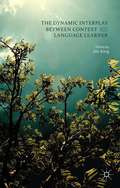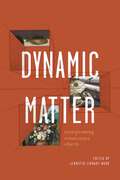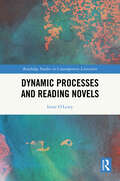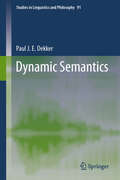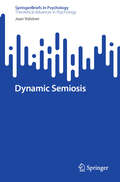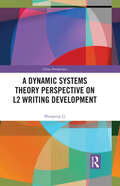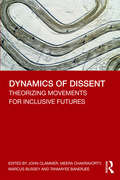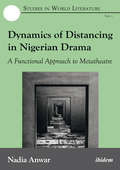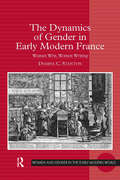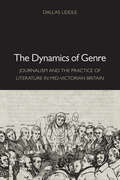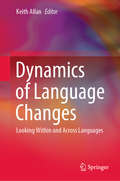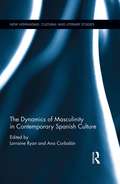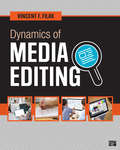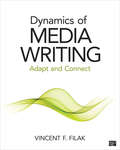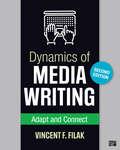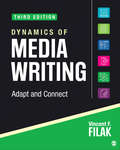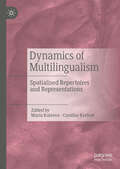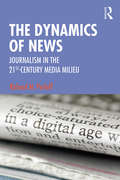- Table View
- List View
The Dynamic Interplay between Context and the Language Learner
by Jim KingThis edited volume offers a series of state-of-the-art conceptual papers and empirical research studies which consider how contextual factors at multiple levels dynamically interact with individuals to influence how they go about the complex business of learning and using a second language.
Dynamic Matter: Transforming Renaissance Objects (Cultural Inquiries in English Literature, 1400–1700)
by Jennifer Linhart WoodDynamic Matter investigates the life histories of Renaissance objects. Eschewing the critical tendency to study how objects relate to human needs and desires, this work foregrounds the objects themselves, demonstrating their potential to transform their environments as they travel across time and space.Integrating early modern material theories with recent critical approaches in Actor-Network Theory and object-oriented ontology, this volume extends Aristotle’s theory of dynameos—which conceptualizes matter as potentiality—and applies it to objects featured in early modern texts such as Edmund Spenser’s The Faerie Queene, Robert Hooke’s Micrographia, and William Shakespeare’s The Tempest. Individual chapters explore the dynameos of matter by examining its manifestations in particular forms: combs are inscribed with words and brushed through human hair; feathers are incorporated into garments and artwork; Prince Rupert’s glasswork drops explode; a whale becomes animated by the power of a magical bracelet; and books are drowned. These case studies highlight the potentiality matter itself possesses and that which it activates in other matter. A theorization of objects grounded in Renaissance materialist thought, Dynamic Matter examines the richness of things themselves; the larger, multiple, and changing networks in which things circulate; and the networks created by these transformative objects.In addition to the editor, the contributors to this volume include Anna Riehl Bertolet, Erika Mary Boeckeler, Naomi Howell, Emily E. F. Philbrick, Josie Schoel, Maria Shmygol, Edward McLean Test, Abbie Weinberg, and Sarah F. Williams.
Dynamic Processes and Reading Novels (Routledge Studies in Contemporary Literature)
by Irene O’LearyThis book is about the dynamic processes that generate novel-reading. It takes the view that the world is composed of dynamic processes and introduces a process dynamics approach to articulate this stance. This fresh perspective draws on literary studies, process philosophy and neuroscience to argue that dynamic literary and microcognitive processes constantly reconfigure the conditions that they co-create during reading. Analyses of The PowerBook by Jeanette Winterson, The Curious Incident of the Dog in the Night-time by Mark Haddon and Oryx and Crake by Margaret Atwood consider style, narration, allusion and creativity in interaction with diverse microcognitive processes involved in reading. The analyses are strengthened by taking live action into account, illuminating changes that many critical perspectives miss or standardise and avoiding reliance on illusory ideal readers and readings. In proposing a process approach to dynamics and its analysis, this book paves the way for new research across disciplines.
Dynamic Semantics
by Paul J.E. DekkerThe integrated theory of dynamic interpretation set out here will be a surprise to advanced researchers in linguistics. It combines classical formal semantics and modern dynamic semantics without altering the fundamental paradigm. At the book's core lies a pragmatically motivated notion of a dynamic conjunction of meanings, an idea that is worked out in full formal detail. This is applied to linguistic phenomena that involve anaphora, quantification and modality. The author demonstrates that in each area of application existing data can be neatly combined with new dynamic insights, but more importantly, there is a genuine further pay-off: the work generates treatments of phenomena that were not initially intended, with functional readings of pronouns and quantifiers, 'Hob-Nob' sentences, and insights into what we now call 'Pierce's Puzzle'. The outcome of a decade of work by the Amsterdam School of dynamic semantics, this volume condenses and reflects upon a vital body of research.
Dynamic Semiosis (SpringerBriefs in Psychology)
by Jaan ValsinerThis book aims to bring to readers the author’s elaborated focus on the dynamic process of sign emergence, use, fixation and un-fixation, and dismissal. Its uniqueness is in its reliance on the organizing limits of irreversible time that renders the meaning construction by human beings to be constantly open-ended to face the uncertainties of the immediate future. This book emerged from a 9-month series of seminars at the Department of Semiotics at Tartu University in 2021-2022 as a Välis-Eesti Külalisprofessor, during which the linkages between semiotics and cultural psychology were scrutinized. In collaboration with doctoral students from various countries, the present SpringerBrief outlines the theoretical innovations that the author started during the seminars but completed in the two years after their end.
A Dynamic Systems Theory Perspective on L2 Writing Development (China Perspectives)
by Shaopeng LiFrom the perspective of empirical complex dynamic systems, this book investigates the complex and nonlinear process of L2 writing centering on three linguistic aspects of L2 writing development: vocabulary, syntax, and discourse.Combining dynamic systems theory, variation analysis, as well as data and cases studies from Chinese EFL learners’ writing, the book critically engages with the heated discussion on dynamic patterns of L2 writing development that focus heavily on the linguistic dimensions of complexity, accuracy, and fluency. The author expands the scope of the research by integrating both linguistic and functional dimensions of L2 output and examines the interaction and co-development of these dimensions. This framework helps delineate a full picture of individual learners’ L2 writing dynamic patterns across all components of their communicative repertoire. The research findings suggest the developmental path of writing system for each EFL learner may differ, which is influenced by their different learning characteristics and learning environments in China.The title will appeal to scholars interested in applied linguistics and second language acquisition. Suggestions on pedagogy and language learning advanced in the book will also make it a useful read for L2 language learner and TESOL and TEFL teachers.
Dynamics and Performativity of Imagination: The Image between the Visible and the Invisible (Routledge Research In Cultural And Media Studies #21)
by Bernd Huppauf Christoph WulfIn this interdisciplinary anthology, essays study the relationship between the imagination and images both material and mental. Through case studies on a diverse array of topics including photography, film, sports, theater, and anthropology, contributors focus on the role of the creative imagination in seeing and producing images and the imaginary.
Dynamics of Dissent: Theorizing Movements for Inclusive Futures
by John Clammer Meera Chakravorty Marcus Bussey Tanmayee BanerjeeThis book analyses dissent and its manifestations in movements of social and political transformation across communities and cultures. It shows how these movements create ruptures in the structures of power, and social hierarchy; expressed through songs, slogans, poetry and performances. The chapters in the book explore these sites of transgression and the imprint they leave on culture, politics, beliefs and the collective society – via music and poetry as in the Bhakti movement or through feministic theories born in post-World War Europe. It also explores how these dynamic movements generate alternate spaces within which the self, identity and collective purpose take new forms and find new meanings as they travel. This book will be of interest to students and scholars of the humanities, literature, history, sociology, politics and culture studies.
Dynamics of Distancing in Nigerian Drama: A Functional Approach to Metatheatre (Studies in World Literature #1)
by Nadia AnwarNadia Anwar analyzes select post-independence Nigerian dramas through the conceptual framework of metatheater, a strategy that breaks dramatic illusion to foreground the process of play making. Anwar argues that distancing, as a function of metatheater, fosters a balanced theatrical environment by allowing the emotive and cognitive aspects of reception to dominate the theatergoing experience. She draws on Bertolt Brecht, Thomas J. Scheff, and other theoreticians to critique plays by Wole Soyinka, Ola Rotimi, Femi Osofisan, Esiaba Irobi, and Stella 'Dia Oyedepo.
Dynamics of Emigration: Émigré Scholars and the Production of Historical Knowledge in the 20th Century (Making Sense of History #43)
by Stefan Berger and Philipp MüllerAs a pioneering volume to consider the impact of exile on historical scholarship in the twentieth century in a systematic and global way, looking at Europe, North America, South America and Asia, Dynamics of Emigration asks about epistemic repercussions on the experience of exile and exiles. Analyzing both the impact that exile scholars had on their host societies and on the societies they had to leave, the volume investigates exiles’ pathways to integration into new host societies and the many difficulties they face establishing themselves in new surroundings. Focusing on the age of extremes and the realms of exile from fascist and right-wing dictatorships as well as communist regimes, the contributions look at the reasons scholars have for going into exile while providing side-by-side examination of the support organizations and paths for success involved with living in exile.
The Dynamics of Gender in Early Modern France: Women Writ, Women Writing (Women and Gender in the Early Modern World)
by Domna C. StantonIn its six case studies, The Dynamics of Gender in Early Modern France works out a model for (early modern) gender, which is articulated in the introduction. The book comprises essays on the construction of women: three in texts by male and three by female writers, including Racine, Fénelon, Poulain de la Barre, in the first part; La Guette, La Fayette and Sévigné, in the second. These studies thus also take up different genres: satire, tragedy and treatise; memoir, novella and letter-writing. Since gender is a relational construct, each chapter considers as well specific textual and contextual representations of men. In every instance, Stanton looks for signs of conformity to-and deviations from-normative gender scripts. The Dynamics of Gender adds a new dimension to early modern French literary and cultural studies: it incorporates a dynamic (shifting) theory of gender, and it engages both contemporary critical theory and literary historical readings of primary texts and established concepts in the field. This book emphasizes the central importance of historical context and close reading from a feminist perspective, which it also interrogates as a practice. The Afterword examines some of the meanings of reading-as-a-feminist.
The Dynamics of Genre: Journalism and the Practice of Literature in Mid-Victorian Britain (Victorian Literature and Culture Series)
by Dallas LiddleNewspapers, magazines, and other periodicals reached a peak of cultural influence and financial success in Britain in the 1850s and 1860s, out-publishing and out-selling books as much as one hundred to one. But although scholars have long known that writing for the vast periodical marketplace provided many Victorian authors with needed income--and sometimes even with full second careers as editors and journalists--little has been done to trace how the midcentury ascendancy of periodical discourses might have influenced Victorian literary discourse.In The Dynamics of Genre, Dallas Liddle innovatively combines Mikhail Bakhtin's dialogic approach to genre with methodological tools from periodicals studies, literary criticism, and the history of the book to offer the first rigorous study of the relationship between mid-Victorian journalistic genres and contemporary poetry, the novel, and serious expository prose. Liddle shows that periodical genres competed both ideologically and economically with literary genres, and he studies how this competition influenced the midcentury writings and careers of authors including Elizabeth Barrett Browning, Harriet Martineau, Anthony Trollope, George Eliot, and the sensation novelists of the 1860s. Some Victorian writers directly adopted the successful genre forms and worldview of journalism, but others such as Eliot strongly rejected them, while Trollope launched his successful career partly by using fiction to analyze journalism's growing influence in British society. Liddle argues that successful interpretation of the works of these and many other authors will be fully possible only when scholars learn to understand the journalistic genre forms with which mid-Victorian literary forms interacted and competed.
The Dynamics of Inheritance on the Shakespearean Stage
by Michelle M. DowdEarly modern England's system of patrilineal inheritance, in which the eldest son inherited his father's estate and title, was one of the most significant forces affecting social order in the period. Demonstrating that early modern theatre played a unique and vital role in shaping how inheritance was understood, Michelle M. Dowd explores some of the common contingencies that troubled this system: marriage and remarriage, misbehaving male heirs, and families with only daughters. Shakespearean drama helped question and reimagine inheritance practices, making room for new formulations of gendered authority, family structure, and wealth transfer. Through close readings of canonical and non-canonical plays by Shakespeare, Webster, Jonson, and others, Dowd pays particular attention to the significance of space in early modern inheritance and the historical relationship between dramatic form and the patrilineal economy. Her book will interest researchers and students of early modern drama, Shakespeare, gender studies, and socio-economic history.
Dynamics of Language Changes: Looking Within and Across Languages
by Keith AllanThis book explores the dynamics of language changes from sociolinguistic and historical linguistic perspectives. With in-depth case studies from all around the world, it uses diverse approaches across sociolinguistics and historical linguistics to answer questions such as: How and why do language changes begin?; how do language changes spread?; and how can they ultimately be explained?Each chapter explores a different component of language change, including typology, syntax, morphology, phonology, semantics, lexicology, discourse strategies, diachronic change, synchronic change, how the deafblind modify sign language, and the accommodation of language to song. This book presents a comprehensive analysis of the dynamics of language change over time, simultaneously advancing current research and suggesting new directions in sociolinguistic and historical linguistic approaches.
The Dynamics of Masculinity in Contemporary Spanish Culture (New Hispanisms: Cultural and Literary Studies)
by Lorraine Ryan Ana CorbalanThis collection of essays explores cultural phenomena that are shaping masculine identities in contemporary Spain, asking and striving to answer these compelling questions: what does it mean to be a man in present-day Spain? How has masculinity evolved since Franco’s dictatorship? What are the dynamics of masculinity in contemporary Spanish culture? How has hegemonic masculinity been contested in cultural productions? This volume is comprised of sixteen essays that address these very questions by examining literary, cultural and film representations of the configurations of masculinities in contemporary Spain. Divided into three thematic units, starting with the undermining of the monolithic Francoist archetype of masculinity, continuing with the reformulation of hegemonic masculinity and finishing with regional emergent masculinities, all of the volume´s essays focus on the redefinition of Spanish masculinities. Principal themes of the volume include alternative families, queer masculinities, performative masculinities, memory and resistance to hegemonic discourses of manliness, violence and emotions, public versus private masculinities, regional masculinities, and marginal masculinities. This exploration not only produces new insights into masculinity, but also yields nuanced insights into the recuperation of memory in contemporary Spain, the reconfiguration of the family, the status of women in Spanish society, and regional identities.
Dynamics of Media Editing
by Vincent F. FilakAs traditional newsrooms staffed by journalists and managed by experienced editors become less and less common, there is an even greater need for all types of professional writers to be fluent in the editorial process. Dynamics of Media Editing emphasizes the broad value of editing as both a tool for journalistic management and an essential skill for individual writers of all stripes. Author Vince F. Filak recognizes editing as an essential process for improving the quality of published writing, something that is relevant and essential to investigative journalists, social media interns, celebrity bloggers, and everyone in between. By organizing the book around skills and by platforms, Dynamics of Media Editing shows students how the basic principles of good editing work across disciplines and media platforms. Key Features The emphasis on transferrable skills and multiple platforms shows students how to use the basic principles of good editing for journalism, PR, advertising, or social media marketing. The book takes a broad approach to editing, demonstrating that it’s not just a skill for managers at newspapers, but rather an essential process for improving all aspects of published writing. This addresses a critical course challenge, in that many students don’t see the relevance of editing in their planned careers. The audience-centric method emphasizes the need to engage one’s audience in order to be a successful writer. "Helpful Hints" boxes provide easy-to-consult lists of dos and don’ts for good writing. "Thoughts From a Pro" boxes allow media professionals from a variety of backgrounds to demonstrate the essential function of the editing process in the workplace.
Dynamics of Media Editing
by Vincent F. FilakAs traditional newsrooms staffed by journalists and managed by experienced editors become less and less common, there is an even greater need for all types of professional writers to be fluent in the editorial process. Dynamics of Media Editing emphasizes the broad value of editing as both a tool for journalistic management and an essential skill for individual writers of all stripes. Author Vince F. Filak recognizes editing as an essential process for improving the quality of published writing, something that is relevant and essential to investigative journalists, social media interns, celebrity bloggers, and everyone in between. By organizing the book around skills and by platforms, Dynamics of Media Editing shows students how the basic principles of good editing work across disciplines and media platforms. Key Features The emphasis on transferrable skills and multiple platforms shows students how to use the basic principles of good editing for journalism, PR, advertising, or social media marketing. The book takes a broad approach to editing, demonstrating that it’s not just a skill for managers at newspapers, but rather an essential process for improving all aspects of published writing. This addresses a critical course challenge, in that many students don’t see the relevance of editing in their planned careers. The audience-centric method emphasizes the need to engage one’s audience in order to be a successful writer. "Helpful Hints" boxes provide easy-to-consult lists of dos and don’ts for good writing. "Thoughts From a Pro" boxes allow media professionals from a variety of backgrounds to demonstrate the essential function of the editing process in the workplace.
Dynamics of Media Writing: Adapt and Connect
by Vincent F. FilakDynamics of Media Writing gives students transferable skills that can be applied across all media platforms—from traditional mass media formats like news, public relations, and advertising to emerging digital media platforms. Whether issuing a press release or tweeting about a new app, today’s media writers need to adapt their message for each specific media format in order to successfully connect with their audience. Throughout this text, award-winning teacher and college media adviser Vincent F. Filak introduces fundamental writing skills that apply to all media, while also highlighting which writing tools and techniques are most effective for specific media formats and why. User-friendly and loaded with practical examples and tips from professionals across mass media, this is the perfect guide for any student wanting to launch a professional media writing career.
Dynamics of Media Writing: Adapt and Connect
by Vincent F. FilakDynamics of Media Writing gives students transferable skills that can be applied across all media platforms—from traditional mass media formats like news, public relations, and advertising to emerging digital media platforms. Whether issuing a press release or tweeting about a new app, today’s media writers need to adapt their message for each specific media format in order to successfully connect with their audience. Throughout this text, award-winning teacher and college media adviser Vincent F. Filak introduces fundamental writing skills that apply to all media, while also highlighting which writing tools and techniques are most effective for specific media formats and why. User-friendly and loaded with practical examples and tips from professionals across mass media, this is the perfect guide for any student wanting to launch a professional media writing career.
Dynamics of Media Writing: Adapt and Connect
by Vincent F. FilakThis fully updated Second Edition of Dynamics of Media Writing helps you learn transferable skills that can be applied across all media platforms—from traditional mass media formats like news, public relations and advertising, to digital and social media platforms. Whether writing a story, press release or a tweet, today’s media writers must adapt their message to each specific media format in order to successfully connect with their audience. New to the Second Edition: A new chapter on social media discusses the latest developments in this rapidly changing area. New Helpful Hints boxes help you hone your media writing skills. New and updated information on interviewing, dictionary usage, lead structure and more bring the book fully up-to-date. Themes from the former Chapter 14 are now woven through the book to stress the importance of clarity and accuracy, lifelong learning and transferable skills. Fake news is now covered in multiple sections to help you both understand and spot it when reviewing the news. Additional photos and graphics illustrate the various elements of storytelling to make the information easier for you to apply. New "Give It a Try" features at the end of the Adapt and Connect boxes allow you to try out the skills outlined.
Dynamics of Media Writing: Adapt and Connect
by Vincent F. FilakThis fully updated Second Edition of Dynamics of Media Writing helps you learn transferable skills that can be applied across all media platforms—from traditional mass media formats like news, public relations and advertising, to digital and social media platforms. Whether writing a story, press release or a tweet, today’s media writers must adapt their message to each specific media format in order to successfully connect with their audience. New to the Second Edition: A new chapter on social media discusses the latest developments in this rapidly changing area. New Helpful Hints boxes help you hone your media writing skills. New and updated information on interviewing, dictionary usage, lead structure and more bring the book fully up-to-date. Themes from the former Chapter 14 are now woven through the book to stress the importance of clarity and accuracy, lifelong learning and transferable skills. Fake news is now covered in multiple sections to help you both understand and spot it when reviewing the news. Additional photos and graphics illustrate the various elements of storytelling to make the information easier for you to apply. New "Give It a Try" features at the end of the Adapt and Connect boxes allow you to try out the skills outlined.
Dynamics of Media Writing: Adapt and Connect
by Vincent F. FilakDynamics of Media Writing Third Edition gives students transferable skills that can be applied across all media platforms—from traditional mass media formats like news, public relations, and advertising to emerging digital media platforms. Whether issuing a press release or tweeting about a new app, today’s media writers need to adapt their message for each specific media format in order to successfully connect with their audience. Throughout this text, award-winning teacher and college media adviser Vincent F. Filak introduces fundamental writing skills that apply to all media, while also highlighting which writing tools and techniques are most effective for specific media formats and why. User-friendly and loaded with practical examples and tips from professionals across mass media, this is the perfect guide for any student wanting to launch a professional media writing career.
Dynamics of Media Writing: Adapt and Connect
by Vincent F. FilakDynamics of Media Writing Third Edition gives students transferable skills that can be applied across all media platforms—from traditional mass media formats like news, public relations, and advertising to emerging digital media platforms. Whether issuing a press release or tweeting about a new app, today’s media writers need to adapt their message for each specific media format in order to successfully connect with their audience. Throughout this text, award-winning teacher and college media adviser Vincent F. Filak introduces fundamental writing skills that apply to all media, while also highlighting which writing tools and techniques are most effective for specific media formats and why. User-friendly and loaded with practical examples and tips from professionals across mass media, this is the perfect guide for any student wanting to launch a professional media writing career.
Dynamics of Multilingualism: Spatialised Repertoires and Representations
by Maria Kuteeva Caroline KerfootThis edited book focuses on the ways in which contemporary societal challenges are constructed, mediated and lived through language and other semiotic modalities in new on- and off-line spaces. It conceives of linguistic repertoires as part of dynamic assemblages that can enable an understanding of the ways in which different bodies, lived experiences, discourses, semiotic resources, and objects intra-act, change and ‘become’ together in unpredictable ways. The chapters reveal the conditions under which such assemblages occur and the nature of the entangled elements that enable certain practices to emerge and then either to endure or disappear, drawing on a range of critical sociolinguistic and discourse analytical methods to explore how histories, languages, bodies, and the material realisation of each space intra-act in the production of determinations of (linguistic) legitimacy and worth, shaping contemporary ideologies of belonging and, thereby, other possibilities. This book will be of interest to students and researchers in fields including sociolinguistics, anthropology, migration studies, and education.
The Dynamics of News: Journalism in the 21st Century Media Milieu
by Richard PerloffThis new and highly readable textbook by Richard M. Perloff introduces students to the complex world of contemporary news and its theoretical underpinnings, engaging with debates and ethical quandaries. The book takes readers on a concept-guided tour of the contours, continuities, and changing features of news. It covers a huge breadth of topics including: the classic theories of what news should do, its colorful history in America and popular myths of news, the overarching forces involved in contemporary news gathering, critical economic determinants of news and social system influences, and innovative trends in the future of journalism. Drawing on scholarship in the fields of journalism studies and sociology of news, Perloff offers readers a critical, in-depth exploration of news filled with relevant examples from newspapers, newscasts, and social media. Students of journalism, communication, sociology, politics, and related courses, as well as inquisitive scholars, will find this book’s intellectual focus enriching, the writing and examples engaging, and the thoroughness of its search of the contemporary media scene invigorating. Boxes summarizing theory and key concepts help students to deepen their understanding of both what news is now and its future.
